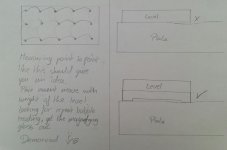lowCountryCamo
Stainless
- Joined
- Jan 1, 2012
- Location
- Savannah, Georgia, USA
I have a Collins micro flat 6 by 18 by 3 square/straight edge combination and a Chinese B 9 by 18 plate that are contradicting each other. The micro flat is printing convex and plate concave. The plate is supported at 3 points. The mico flat was calibrated in 1989 and considering the shape was probably not used much accept for a square, hence maybe worn much. I guess it is my fault for not buying a better plate. I have another Chinese gem, a level with .0005 resolution. Is it possible the map out the error with a level like this? Thanks.


